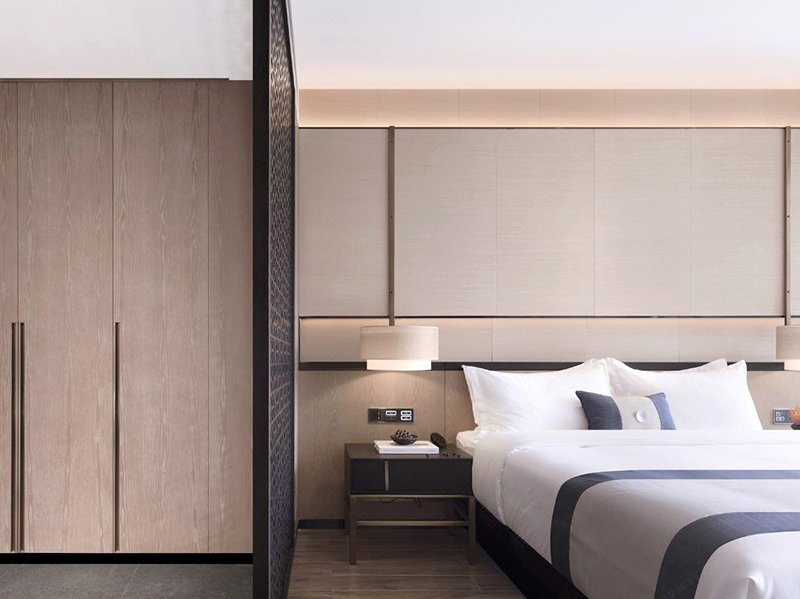Release time:2022-02-17 author:Kyatt hotel furniture Co.,Itd
When purchasing natural wood veneer, precautions should be taken:
1. Carefully check the light transmittance of the wood veneer. Generally speaking, the better light transmittance of the wood veneer, the worse the quality.
2. Carefully inspect the surface of the wood veneer for obvious damage, scratches, or cuts. Note that wood veneer with obvious damage, scratches, or cuts is generally considered defective or unqualified.
3. Carefully examine the grain and color of the wood veneer. The grain is clear, the eyelets are natural, and the smooth color of the wood veneer is generally preferred.
4. Due to the complexity of the natural wood veneer process, there are high requirements for dyeing technology, related process equipment, and on-site management. Therefore, the inspection of the quality of natural wood veneer can not only refer to market product samples, but also have the opportunity to further understand and consult with relevant manufacturers to ensure that the product quality achieves long-term stable and reliable supply.
5.Pay attention to the production cycle inspection and service capabilities of products. Generally speaking, the production cycle of natural wood veneer is more than one month, and capable manufacturers can have the ability to plan production and provide efficient services as a whole. They can shorten mature products and production cycles to between 15 and 20 days, while the supply cycle can be controlled to around 3-10 days, providing you with strong service guarantee.
6.Pay attention to the scale and strength of the manufacturer. Currently, the wood resources are relatively tight, and the main materials of natural wood veneer are poplar, wutong and basswood. The natural wood veneer manufacturers need to have the corresponding strength to ensure the smoothness of raw materials and the stable supply of products.
The distinction between solid wood furniture, natural wood veneer furniture, and sticker furniture. Solid wood is commonly used in varieties and parts with fewer materials, and precious wood is rarely used. For example, solid wood dining chairs are relatively common, but they are generally made of imported beech wood for mid to high end items, maple, birch, or domestic beech wood for mid end items, and rubber wood for low end items.

There are many decorative materials for modern panel furniture, among which wood veneer and stickers are commonly used, but the grades are completely different. Wooden furniture is rich in natural texture, beautiful and durable, but relatively expensive. Sticker furniture is prone to wear, water resistance, and collision resistance, but it is a low-cost and popular product. Some furniture varieties that are not severely worn and not close to water sources are currently mainly made of stickers, such as shoe cabinets, bookcases, etc.
When customers visit a furniture store, they will see instructions on price tags such as "Walnut wood floor cabinets", "Cherry wood coffee tables", and "Beech wood dining chairs". At this point, it is crucial to determine whether it is solid wood, veneer, or stickers. Solid wood and veneered furniture can be referred to as "cherry wood furniture", but stickers can only be referred to as "cherry wood grain furniture", otherwise it would be an act of confusion.
Solid wood: Wood grain, wood rays (usually manifested as "needles" if any) are clearly visible, and there should be some natural defects (knots, wood spots, black lines, etc.) to some extent. The natural connection between the longitudinal and transverse sections of the two intersecting interfaces of the same solid wood, whether it is a wooden board or a wooden strip, should be clearly visible.
Wood veneer: The wood grain and ray are clear. There should also be natural flaws. Due to the thickness of the wood veneer (around 0.3-0.6mm), when making furniture, two adjacent interfaces are usually not turned, but each one is pasted. Therefore, the wood grain at the two interfaces should not be connected. Wood veneer is made by cutting and processing natural logs, which reduces damage to the natural environment and reduces furniture costs. It is loved by the general public.
Sticker: The wood grain and ray are clearly visible, and even imported high-end paper can be imitated with wood defects, but it is still different from natural wood veneer and appears more fake. Sticker furniture can easily reveal cracks at the edges and corners. In addition, due to the small thickness (0.08mm) of the wood grain paper, it will directly wrap over the intersection of two planes, resulting in the wood grain at the two interfaces being connected (usually in longitudinal sections).
 Previous:Personalized demand may make customized furniture a future consumption hotspot
Previous:Personalized demand may make customized furniture a future consumption hotspot
 Next:Which brand is better for imported hotel furniture? Can it be customized in China?
Next:Which brand is better for imported hotel furniture? Can it be customized in China?
0086-757-88810171